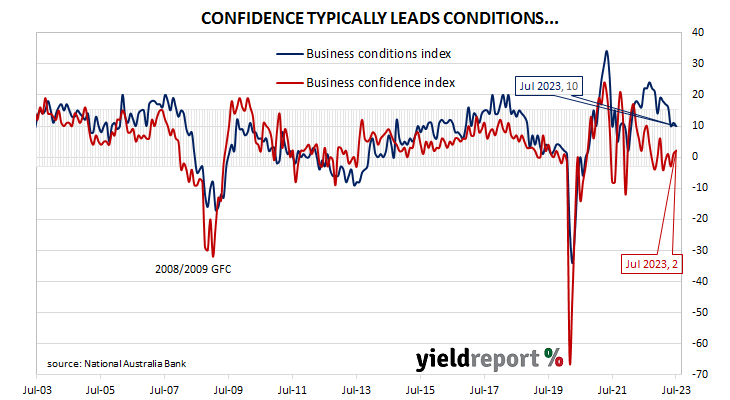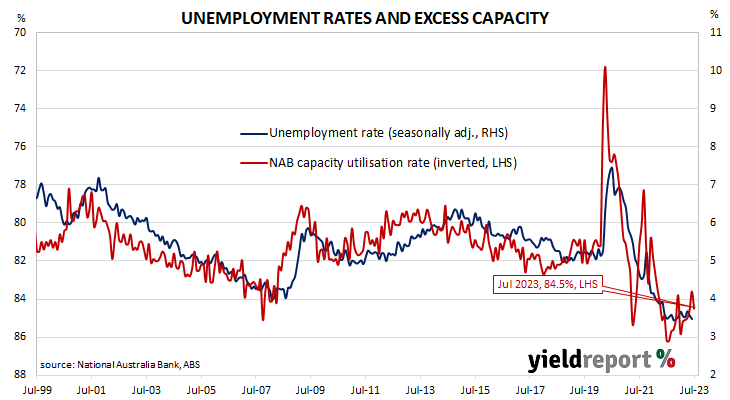Summary: Business conditions slip in July; business less pessimistic, still below average; conditions resilient, challenges expectations economy would continue to cool; Westpac: provides further confirmation of trend cooling, price pressures lifting; capacity utilisation rate rises, at elevated level.
NAB’s business survey indicated Australian business conditions were robust in the first half of 2018, with a cyclical-peak reached in April of that year. Readings from NAB’s index then began to slip and forecasts of a slowdown in the domestic economy began to emerge in the first half of 2019 as the index trended lower. It hit a nadir in April 2020 as pandemic restrictions were introduced but then conditions improved markedly over the next twelve months.
According to NAB’s latest monthly business survey of around 400 firms conducted in last week-and-a-half of July, business conditions slipped slightly to a level which is still slightly above average. NAB’s conditions index registered 10 points, down from June’s revised reading of 11 points.
Business confidence improved for a second consecutive month. NAB’s confidence index rose from June’s revised reading of 1 point to 2 points, still below the long-term average. Typically, NAB’s confidence index leads the conditions index by one month, although some divergences have appeared from time to time.
“Business conditions stayed resilient in July and inflation-related measures rose, challenging expectations that the economy would continue to cool as 2023 wears on,” said NAB Chief Economist Alan Oster.
The report was released on the same day as the latest Westpac-Melbourne Institute consumer sentiment survey and Commonwealth Government bond yields generally fell moderately on the day. By the close of business, the 3-year ACGB yield had lost 5bps to 3.72%, the 10-year yield had shed 6bps to 4.01% while the 20-year yield finished 1bp lower at 4.37%.
In the cash futures market, expectations regarding further rate rises softened. At the end of the day, contracts implied the cash rate would barely change from the current rate of 4.07% to average 4.08% in September and 4.11% in October. February 2024 contracts implied a 4.185% average cash rate while May 2024 contracts implied 4.15%, 8bps more than the current rate.
Westpac senior economist Andrew Hanlan’s view was not quite as positive as NAB’s Oster. “The latest private business survey provided further confirmation of a trend cooling of business conditions, that business confidence is soft and fragile and that forward orders are contracting.” However, as with Oster, he also noted the report’s inflation-related aspects. “On the price front, July readings lifted across labour costs, purchase costs and prices, both final product and retail.”
NAB’s measure of national capacity utilisation increased from June’s revised reading of 83.6% to 84.5%, a historically-elevated level. All eight sectors of the economy were reported to be operating above their respective long-run averages.
Capacity utilisation is generally accepted as an indicator of future investment expenditure and it also has a strong inverse relationship with Australia’s unemployment rate.



